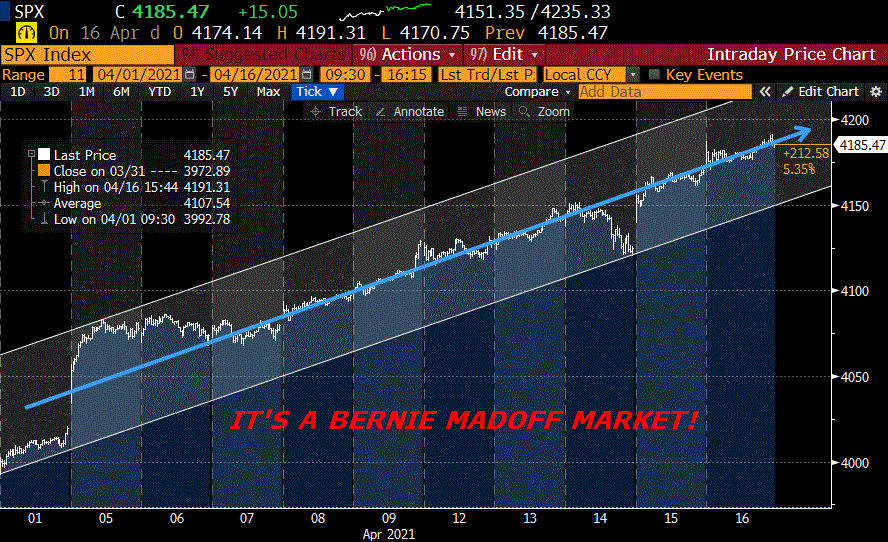MADoff Market
April 18, 2021 – Weekly comment
____________________________________
This week I start with the standard Federal Reserve disclaimer: …before I begin my commentary, I am obliged to remind you that the views I express are my own and do not necessarily reflect the views of my colleagues at RJO or within the RJO group of companies and affiliates.
Bernie Madoff, who ran the biggest Ponzi investment scheme ever, at least in his time, died in prison last week. Madoff’s secretive fund was brought down by Harry Markopolos, the account of which is in his book, No One Would Listen.
To commemorate the passing of this great man, SPX, in the month of April, has consistently rallied with very little variation. Since April Fool’s day it has gone up about 5%.

The reason Markopolos began looking into Madoff’s activities was because the returns were invariably consistent without drawdowns. From the book:
After going through my work [examining returns on a basket of 35 stocks using a split-stock conversion strategy] Dan told us that whatever Madoof, as he referred to him, was doing, he was not getting his results from the market. Pointing to the 6 percent correlation and the 45 degree return line, he said “That doesn’t look like it came from a finance distribution. We don’t have those kinds of charts in finance.” I was right, he agreed. Madoff’s strategy description claimed his returns were market-driven, yet his correlation coefficient was only 6 percent to the market and his performance line certainly wasn’t coming from the stock market. Volatility is a natural part of the market.
Madoff’s written material said he used OEX options for collars, but Markopolos noted there was absolutely no evidence that trades of the size required by Madoff’s fund had occurred; they would have left a footprint even if they had been done over-the-counter. The book presents a scathing indictment of the SEC, who Markopolos had contacted with his mathematical evidence several times, only to be brushed off.
How did Madoff do it? He paid feeder funds lavish fees (stimulus checks). Many investors thought that he was front-running his own brokerage arm, but they still happily accepted the juice (Robinhooders). New investors (the Fed) were streaming in funds to provide the returns to existing clients. The philanthropic lifestyle of a knowing patriarch who had held leadership roles like Chairman of Nasdaq (Biden) set people’s minds at ease. Now I’m not saying the US equity market resembles a giant Ponzi scheme, just pointing out a couple of coincidental similarities. At this point the Fed and the Treasury and the SEC know exactly what they’re doing. Right?
On a side note, at least not ALL is lost. Morgan Stanley is still in the process of recovering collateral.

The economic and inflation data continue to surprise on the upside, but the bond market absorbed it all in stride. Some year-over-year US data snippets from last week: CPI +2.6%, Real Avg Weekly Earnings +3.9%, Import Price Index +6.9%, Export Price Index +9.1%. U Mich 1-year Inflation 3.7%, with 5-10yr 2.7%. Retail Sales were up 9.8% in March. The thirty year bond yield FELL 8.2 bps on the week to 2.26%, while the ten year dropped nearly 10 bps to 1.57%. The curve flattened with 2/10 down just over 10 bps to 140.8. Yields don’t exactly seem to be compensating for rising prices. In fact, Fed speakers are going to great lengths to convince the public that any rise in inflation is simply a figment of their imagination, I mean, temporary. For example, new Fed Governor Christopher Waller said on Friday, that “whatever temporary surge in inflation we see right now is not going to last.” Might as well say, “If I whack you in the head with this shovel, the pain will eventually subside.” You know, and I know, that this has nothing to do with inflation, but it’s worth a cursory mention that the Bloomberg Commodity Index is up 40% in the past year.
It’s also worth noting that the 10 year Bund ended the week at -26 bps, just 10 off the high since the middle of 2019, which was set in January 2020 at -16 bps. A downward sloping trendline since the high yield in 2008 (4.68%) has been broken. Perhaps some of the strength in US fixed income is coming from flows out of other markets due to geopolitical concerns. On that note, consider China…
Doug Noland of Credit Bubble Bulletin outlines the issues with China’s Huarong Asset Mgmt, citing the spike in CDS. Between June 2020 and March 2021, China Huarong International Holdings, Ltd 5y CDS ranged between 200 and 115 bps. On April 1st, 187. On April 16th 1466 bps, ending the week at 956 (BBG). Noland includes this clip from Bloomberg, which I find somewhat amusing:
April 14 – Bloomberg (Richard Frost): “Market turmoil surrounding China Huarong Asset Management Co. intensified on Wednesday as investors interpreted government silence on the embattled firm as a lack of official support. The Communist Party has yet to comment on the distressed-debt manager, which is controlled by the finance ministry, even as concern about a potential restructuring sent its dollar bonds plunging to distressed levels. China’s State Council, the country’s top administrative body, instead reinforced the idea that struggling state-backed companies shouldn’t rely on government support. In a statement late Tuesday, the State Council urged local government financing vehicles to restructure or enter liquidation if they can’t repay their debts. While it’s unclear if the comments were meant to send a veiled message about China Huarong, they added to the perception that the government is taking a tough stance on reining in risks to the financial system.”
Huarong was set up by the State as a bad bank to buy non-performing loans in the 1990s. It apparently ran a bit wild and accumulated a lot of distressed debt, and the Chairman was executed in January for taking bribes. Who would have thought that a “distressed-debt manager” would see its bonds trade at distressed levels? Isn’t there any value in diversification? Noland estimates debt between $162 and $209 billion. Now the CCP Finance Ministry is going to have to set up a bad bank to absorb bad banks. Maybe the Fed can help with funding by setting up an SPV.
| 4/9/2021 | 4/16/2021 | chg | ||
| UST 2Y | 15.5 | 16.1 | 0.6 | |
| UST 5Y | 86.8 | 81.9 | -4.9 | |
| UST 10Y | 166.7 | 156.9 | -9.8 | |
| UST 30Y | 234.2 | 226.0 | -8.2 | |
| GERM 2Y | -70.2 | -69.0 | 1.2 | |
| GERM 10Y | -30.3 | -26.2 | 4.1 | |
| JPN 30Y | 67.6 | 65.3 | -2.3 | |
| CHINA 10Y | 321.0 | 316.0 | -5.0 | |
| EURO$ M1/M2 | 10.0 | 8.0 | -2.0 | |
| EURO$ M2/M3 | 44.0 | 39.0 | -5.0 | |
| EURO$ M3/M4 | 73.0 | 67.0 | -6.0 | |
| EUR | 119.02 | 119.86 | 0.84 | |
| CRUDE (active) | 59.32 | 63.19 | 3.87 | |
| SPX | 4128.80 | 4185.47 | 56.67 | 1.4% |
| VIX | 16.69 | 16.25 | -0.44 | |
http://creditbubblebulletin.blogspot.com/

